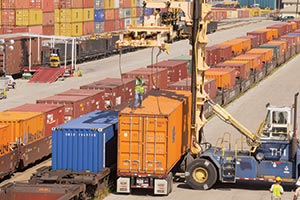Truck-Rail Freight Falls 5.5% in 2nd Quarter

This story appears in the July 18 print edition of Transport Topics.
Truck-rail freight in the second quarter fell by 5.5%, the largest year-over-year decline since late 2009. The fall was driven by a weak economy, a market share skirmish with over-the-road trucking and 2015 market dislocations that inflated shipments last spring, industry experts said.
Total intermodal shipments by U.S. railroads fell to 3.37 million from 3.57 million, the Association of American Railroads reported for the 13-week period ending July 2. It was the largest drop since a 16% slide in the third quarter of 2009.
The second-quarter results also reversed both short- and long-term trends. Second-quarter intermodal freight barely topped the 3.34 million shipments in the first quarter, far below the typical sequential increase from quarter to quarter.
First-quarter 2016, intermodal volume rose 1.5% from the same period of 2015, on top of record truck-rail volumes for all of 2015. Despite the recent decline, intermodal fared better than the overall 8% drop in second-quarter rail volume. Intermodal totals once again exceeded all other rail freight in the second quarter.
FTR consultant Larry Gross, a former intermodal industry executive, told Transport Topics that last year’s second-quarter totals were inflated by the surge in container freight that followed early 2015 freight declines due to West Coast port labor disruptions. He also cautioned that one bad quarter doesn’t signal a long-term intermodal decline.
Rail analyst Justin Long at Stephens Inc. also tied the decline to international intermodal volumes, saying he believes domestic intermodal levels are more stable.
“The rails are consistently blaming softness on elevated retail inventories and mixed retail sales trends,” Long wrote in a report. There is a heightened level of focus around understanding if this is a temporary lull (i.e., we just need destocking) or a sign of consumer demand entering a time of more prolonged weakness.”
“Rail traffic remains relatively weak. Continued weakness in intermodal [is] caused in part by an inventory overhang and global economic uncertainty,” said John Gray, AAR senior vice president of policy and economics.
Independent rail analyst Anthony Hatch focused on the sharp drop in prices of commodities such as oil and coal, which have hurt the rails and haven’t sparked much additional consumer or broad manufacturing demand.
“Consumers have taken the money [they saved] and gone out to buy larger, more expensive cars and gone out to eat more,” he said, instead of buying consumer goods. The resulting higher inventory has hurt intermodal and truckload freight alike, Hatch added, noting comments from carriers such as Werner Enterprises that truckload markets also are weak.
As a result, Hatch believes rail has lost little, if any, market share to truckers.
American Trucking Associations Chief Economist Bob Costello said market share shift is minimal.
“On the margins, some freight goes back and forth between the two modes based on the price of fuel and other factors,” he said. “There might be a little bit of that. Diesel is up, but it is still relatively low. Trucks and trains compete on a very limited basis, with less than 10% of all truck and train freight being competitive.”
He also noted that truckload shipments were little-changed in the second quarter, despite stronger April and May tonnage gains.
“There is a bit of a market share battle, but there is not a lot of migration either way,” said Gross, particularly in shorter-haul markets.
The second half appears to be in question.
“Most [rail] carriers expect a better second half than the first half,” Hatch said. “It’s not too late to pull the chestnuts out of the fire.”
The rail freight slump has lingered longer than expected, he said, because of the drop in commodity prices.
Gross isn’t so sure about the second half.
“Right now, things are looking pretty crappy. It’s a question of how much the economy continues to grow,” Gross said. “Things aren’t going to change much in terms of competitive stances until [capacity] tightens up on the truck side.”
He anticipates a more normal freight pattern this year, with a possible fall peak in August, in line with normal patterns.
“If there is a peak in the third quarter, then the intermodal numbers are going to look pretty good,” Gross said.
“Expect relatively stable volumes in coming weeks,” KeyBanc Capital Markets analyst Todd Fowler said in a report, with more normal volumes after the port-related events.
“While elevated inventories, lower diesel prices and available truck capacity represent headwinds, improved rail service and anecdotal commentary indicating stable import demand suggest a generally balanced outlook,” he said.
Fowler believes intermodal container freight volumes vary sharply by carrier, including a decline of 10% at Union Pacific, smaller drop-offs at BNSF and CSX and 2.1% higher Norfolk Southern volume.

